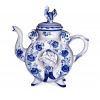|
 Gzhel is a district
of 27 villages known as Gzhel clump. It is not far from Moscow (about 60 km). Gzhel is known all over
the world for its white-burning clay and wonderful white-and-blue pottery. Gzhel
clays have always been a source of wealth for local inhabitants. Different types
of clay have been mined here from the middle of XVII century. In 1770, by the
edict of Tsar Alexei Mikhailovich («the Quiet» royal was an expert in
tableware) Gzhel volost was attributed to the Pharmaceutic Order to manufacture
medical glass. Gzhel is a district
of 27 villages known as Gzhel clump. It is not far from Moscow (about 60 km). Gzhel is known all over
the world for its white-burning clay and wonderful white-and-blue pottery. Gzhel
clays have always been a source of wealth for local inhabitants. Different types
of clay have been mined here from the middle of XVII century. In 1770, by the
edict of Tsar Alexei Mikhailovich («the Quiet» royal was an expert in
tableware) Gzhel volost was attributed to the Pharmaceutic Order to manufacture
medical glass.
The quality
of Gzhel clays was highly esteemed not only by the Tsar but by Lomonosov who wrote:
«There is hardly a land on the earth so clean and non-polluted, called by
chemists a virgin land, as the clay for pottery making, as our Gzhel land; I
have never seen a clay which would be as white as it is» - these words sound like
a romantic ode.
But famous painted
«blue» Gzhel pottery known worldwide emerged not at once. First, Gzhel
manufactured usual earthenware or majolica, called ‘black', then the masters
began making glazed pottery (the glaze conferred transparency and airiness to
it).
Light gray clay
was found in 1802, since that time Gzhel started to manufacture half-faience
pottery.
Approximately
at that time the white faience mass was found in the village of Volodino, and
in 1804 а first porcelain factory in Gzhel started working. The beginning was unassuming
as only two people worked on the factory, the owner himself (Pavel Kulikov who
learned the technique of porcelain making from the masters of Otto's plant in
the village of Perovo) and one hired worker.
Pavel
Kulikov wished to keep «the porcelain know-how» secret, but it was revealed. The
tradition says that the pot makers Khrapunov and Gusyatnikov using the methods
of industrial spying or, simply breaking and entering, copied the design of the
biscuit furnace and ran away with the specimens of clay. As a result, another two
porcelain factories were founded in Gzhel.
These factories
produced not only porcelain ware but different toys and painted them in various
colors - purple, yellow, blue, brown. As the masters were out of folk midst,
the motives of painting were the same, and the decorative toys were in folk
style and national folk tradition, reflecting themes of folk culture.
Gzhel ceramics
always images life, and this is Russian life. Even if it is a classic Indian elephant,
is always has a typical Russian color. Among the Gzhel masterpieces there are girls
with shoulder-yoke and buckets, domestic and household genre-pieces (for
example, typical Russian woman sitting at the table, and a kitten trying to
jump upon her knees - an affecting and touching thing). Fairy-tale characters inspiring
the masters of Gzhel are almost all Russian: a wolf and a lamb, a vulture, a
raven carrying water of life and water of death, Ivan-tsarevich (prince) and
many others. The painting is seemingly simple but the masters succeed in making
their characters instantly recognizable.
An exclusively
blue painting became a trademark of Gzhel only in the early XIX century. But
the contemporary masters of Gzhel hold up the old traditions. In the world of unification,
automation and cybernation every item of Gzhel is painted manually.
Gzhel style
is instantly recognizable; it is never confused with anything else. Ornaments
and flowers of deep and light blue, keeping the genius of ancient Russia - this
is all Gzhel. The painting is made with cobalt paint diluted in water. When the
item is in work it seems to be «plain blue» but after burning various tints appear
and the blue color alone reflects the diversity of color palette of the world.
The art of Gzhel
is taught from the cradle. Children learn the elements of it in the day nursery,
then at school, and afterwards in the Gzhel Art College. Some take courses in Moscow,
and a newly-qualified master is ready to start working. So, needless to say
that all Gzhel masters are very skilful and gifted painters and artists.
Modern Gzhel
is not limited to pottery, decorative figurines and toys. Talented masters
produce vases, chimneys, chandeliers - every porcelain piece one can imagine. There
is quite a range of various items. Gzhel products are a big run in the world.
|